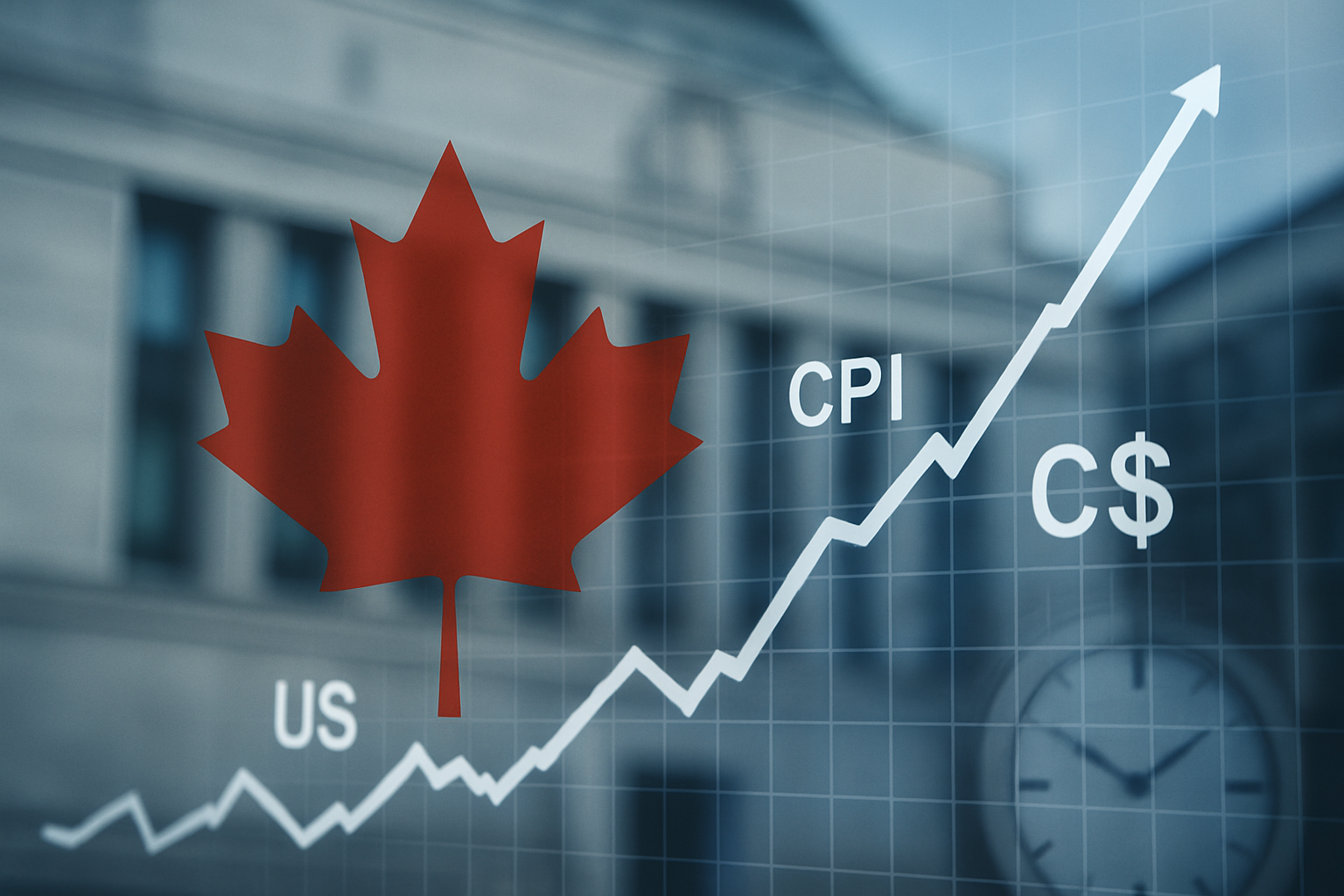
Ottawa, Canada – October 21, 2025 – Canada's financial markets are recalibrating after a surprisingly robust inflation report for September, which saw the annual Consumer Price Index (CPI) accelerate to 2.4%. This unexpected uptick, surpassing both August's 1.9% and market forecasts of 2.3%, has significantly cooled expectations for an imminent interest rate cut from the Bank of Canada (BoC) at its upcoming October 29 policy meeting. In response, the USD/CAD exchange rate, a key barometer for the Canadian economy, initially dipped before stabilizing around the 1.4030 mark, reflecting a newfound resilience in the Canadian dollar.
The "hotter-than-expected" CPI data has injected a fresh wave of uncertainty into the BoC's monetary policy path, which had previously signaled a leaning towards further easing. With headline inflation now exceeding the central bank's 2% target for the first time in six months, policymakers face a delicate balancing act between supporting a slowing economy and taming persistent price pressures. This development has effectively trimmed the perceived urgency for rate reductions, prompting a reassessment of investment strategies across various sectors.
Unpacking the Inflationary Surprise and Market Reaction
The September CPI report, released just days before the crucial Bank of Canada policy meeting, revealed an annual inflation rate of 2.4%, a notable jump from the 1.9% recorded in August. This figure not only defied market consensus but also marked the first instance in half a year that headline inflation has breached the BoC's symmetrical 2% target. On a monthly basis, the CPI edged up by 0.1%, contrary to forecasts that had anticipated a 0.1% decline.
Several factors converged to fuel this inflationary surprise. A smaller year-over-year decline in gasoline prices, recorded at -4.1% in September compared to -12.7% in August due to a base-year effect, played a substantial role. Food costs also exerted upward pressure, with prices for groceries rising 4.0% year-over-year, an acceleration from 3.5% in August, driven notably by fresh vegetables and sugar. Furthermore, a slower year-over-year decline in travel tour prices and persistently rising shelter costs, particularly rent, which accelerated to 4.8% nationally, contributed significantly to the overall inflationary environment.
Adding to the central bank's dilemma, the Bank of Canada's preferred core CPI measures, designed to strip out volatile components, also exhibited stubborn underlying price pressures. The core CPI rose 2.8% over the last twelve months, with a 0.2% monthly increase. Other closely watched gauges, such as Common CPI (2.7%), Trimmed CPI (3.1%), and Median CPI (3.2%), further underscored that inflation is proving more entrenched than previously hoped, despite some policymakers recently questioning the reliability of these metrics.
Prior to this CPI release, market participants had largely priced in another 25-basis-point rate cut by the Bank of Canada at its October 29 meeting, following a similar cut in September amid concerns over a softening labor market and sluggish GDP growth. However, the unexpected inflation data has dramatically shifted this outlook. The probability of a 25 bps rate cut at the upcoming meeting has now eased to approximately 74%, a significant drop from 86% before the report. This reassessment led to an immediate strengthening of the Canadian dollar, with the USD/CAD pair dipping towards the 1.4000 level before steadying around 1.4030, as traders unwound some of their bearish CAD bets.
Corporate Implications: Winners and Losers in a Higher-for-Longer Rate Environment
The recalibration of interest rate expectations and the Canadian dollar's stabilization following the CPI data will undoubtedly create ripple effects across various sectors of the Canadian economy, impacting public companies differently.
Financial institutions, particularly the major Canadian banks, stand to benefit from a "higher-for-longer" interest rate environment. Companies such as Royal Bank of Canada (TSX: RY), The Toronto-Dominion Bank (TSX: TD), Bank of Nova Scotia (TSX: BNS), Bank of Montreal (TSX: BMO), Canadian Imperial Bank of Commerce (TSX: CM), and National Bank of Canada (TSX: NA) could see an expansion of their net interest margins as their loan portfolios re-price more quickly than their deposit costs. Similarly, large insurance and financial services companies like Great-West Lifeco Inc. (TSX: GWO), Sun Life Financial Inc. (TSX: SLF), and Manulife Financial Corporation (TSX: MFC) may also find their profitability bolstered by sustained higher rates.
Conversely, interest-sensitive sectors are likely to face headwinds. Utilities, which are highly capital-intensive and rely heavily on debt financing for infrastructure projects, will contend with elevated borrowing costs. Companies like Fortis Inc. (TSX: FTS) and Northland Power Inc. (TSX: NPI) may see their project financing become more expensive, potentially impacting future growth or dividend sustainability. The real estate sector is another prime example, with developers, homebuilders, and Real Estate Investment Trusts (REITs) like RioCan Real Estate Investment Trust (TSX: REI.UN) and Allied Properties Real Estate Investment Trust (TSX: AP.UN) experiencing dampened demand due to higher mortgage rates and increased costs for development financing.
Furthermore, the stabilization or potential strengthening of the Canadian dollar, driven by reduced rate cut expectations, presents a mixed bag for companies with significant international exposure. Canadian exporters, particularly those in the commodity sector like Suncor Energy Inc. (TSX: SU), Canadian Natural Resources Limited (TSX: CNQ), and precious metals miners such as Agnico Eagle Mines Limited (TSX: AEM), who often earn revenues in U.S. dollars but incur costs in Canadian dollars, might see their profitability squeezed as their foreign earnings translate into fewer Canadian dollars. Conversely, importers and retailers that source goods from abroad could benefit from a stronger CAD, as it lowers their input costs and potentially boosts their margins.
Broader Significance and Policy Dilemmas
The unexpected surge in Canadian CPI data carries significant wider implications, highlighting the persistent challenges faced by central banks globally in navigating post-pandemic economic volatility. This event underscores the Bank of Canada's ongoing struggle to strike a delicate balance: addressing persistent inflation without stifling an economy already showing signs of weakness. The BoC's recent decision to restart its easing cycle in September was predicated on a softening labor market and sluggish GDP growth; the latest CPI figures throw a "curveball" into this narrative, forcing a reconsideration of its forward guidance and potentially impacting its credibility if policy signals become inconsistent.
This situation also illuminates a potential divergence in monetary policy paths between the Bank of Canada and the U.S. Federal Reserve. While the BoC had been leaning towards easing, the Fed's stance has remained more hawkish, largely due to a more resilient U.S. economy. If the BoC is forced to hold rates steady or even consider a more restrictive stance, it could further widen interest rate differentials, influencing capital flows and maintaining a bullish bias on the USD/CAD pair, despite the recent stabilization. This divergence could impact trade relationships, investment decisions, and the competitiveness of Canadian businesses on the global stage.
Historically, periods of unexpected inflation have often led to increased market volatility and a reassessment of central bank independence and effectiveness. The current scenario echoes past dilemmas where central banks grappled with inflationary pressures that proved more stubborn than anticipated, forcing them to pivot from their initial policy trajectories. This event serves as a stark reminder that economic data remains paramount in shaping monetary policy, and policymakers must remain agile in their responses to evolving conditions, even if it means adjusting previously communicated intentions.
The Path Forward: What Comes Next
Looking ahead, all eyes will be on the Bank of Canada's policy announcement on October 29. The decision will be critical in shaping short-term market sentiment and providing clearer guidance on the central bank's path forward. While the probability of a rate cut has diminished, the BoC's accompanying statement and press conference will be scrutinized for clues on its assessment of the economic outlook, its inflation fight, and its willingness to resume rate cuts in the near future. Any hawkish tilt, or even a resolute hold, could further bolster the Canadian dollar.
In the medium to long term, the trajectory of Canadian inflation and economic growth will remain paramount. Investors should closely monitor subsequent CPI reports, labor market data, and GDP figures for signs of either persistent inflationary pressures or a significant economic slowdown that might compel the BoC to reconsider its stance. Global economic developments, particularly commodity prices and the monetary policy decisions of other major central banks, will also play a crucial role in influencing the Canadian dollar and the broader economic landscape.
Analysts currently anticipate the USD/CAD exchange rate to remain within a 1.36-1.40 range through October. However, near-term risks still lean towards mild Canadian dollar weakness due to the lingering impact of rate differentials with the U.S. and persistent softness in crude oil prices, which remain near five-month lows amid oversupply concerns. Companies will need to strategically adapt to a potentially higher-for-longer interest rate environment, focusing on debt management, operational efficiency, and hedging strategies to mitigate currency volatility.
Comprehensive Wrap-up: Navigating the New Economic Reality
The latest Canadian CPI data has delivered a significant jolt to financial markets, forcing a fundamental reassessment of the Bank of Canada's monetary policy trajectory. The unexpected acceleration in inflation has created a clear policy dilemma for the central bank, pushing back the immediate prospects of further interest rate cuts and leading to a stabilization of the Canadian dollar against its U.S. counterpart. This event underscores the inherent unpredictability of economic cycles and the complex interplay between inflation, interest rates, and currency valuations.
Moving forward, the market will operate under increased uncertainty, with the BoC's October 29 decision serving as a pivotal moment. Investors should prepare for potential volatility and remain highly responsive to incoming economic data, particularly inflation reports and labor market indicators. The central bank's communication will be key in providing clarity and managing market expectations.
The lasting impact of this inflation surprise will be felt across various sectors, creating both opportunities and challenges. While financial institutions may benefit, interest-sensitive sectors like real estate and utilities will face continued pressure. Exporters and importers will need to navigate currency fluctuations with heightened vigilance. Ultimately, successful navigation of this evolving economic reality will require agility, robust risk management, and a keen eye on both domestic data and global economic trends in the months to come.
This content is intended for informational purposes only and is not financial advice





